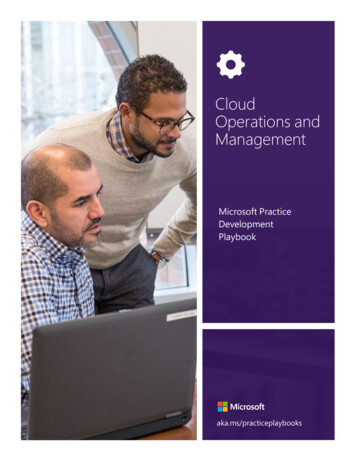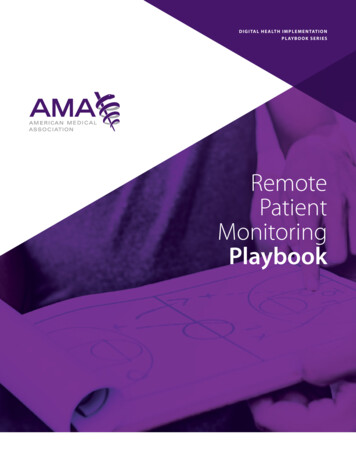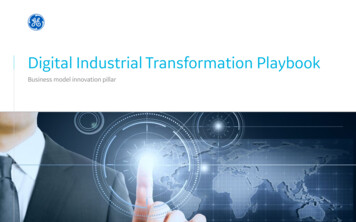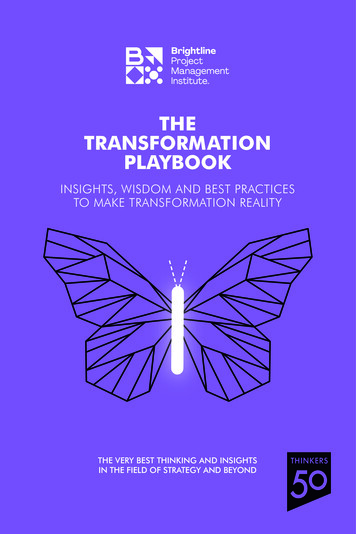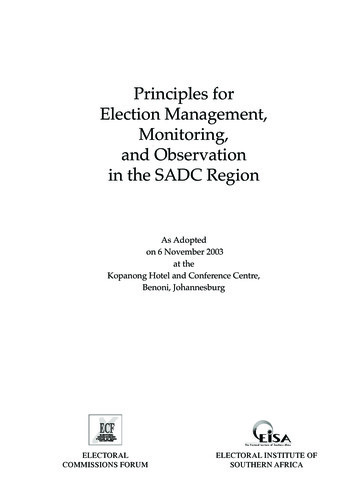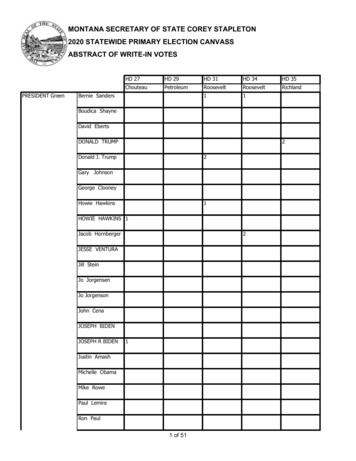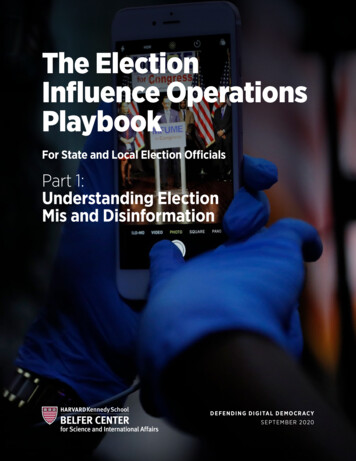
Transcription
The ElectionInfluence OperationsPlaybookFor State and Local Election OfficialsPart 1:Understanding ElectionMis and DisinformationDEFENDING DIGITAL DEMOC RACYSEPTEMBER 2020
Defending Digital Democracy ProjectBelfer Center for Science and International AffairsHarvard Kennedy School79 JFK StreetCambridge, MA 02138www.belfercenter.org/D3PStatements and views expressed in this document are solely those of the authors and do not implyendorsement by Harvard University, the Harvard Kennedy School, or the Belfer Center for Science andInternational Affairs.Design & Layout by Andrew FaciniCover photo: A staff member in the Kweisi Mfume campaign uses gloves while holding a cell phoneduring an election night news conference at his campaign headquarters after Mfume, a Democrat, wonMaryland’s 7th Congressional District special election, Tuesday, April 28, 2020, in Baltimore. (AP Photo/Julio Cortez)Copyright 2020, President and Fellows of Harvard College
DEFENDING DIGITAL DEMOC RACYAUGUST 2020The Election Influence Operations PlaybookTheCybersecurityPart 1: UnderstandingElection Mis andDisinformationCampaign PlaybookContentsAuthors and Contributors.2About the Defending Digital Democracy Project.3The Playbook Approach. 4Executive Summary.5101: Influence Operations, Disinformation and Misinformation. 6What are Influence Operations? Defining Mis/Disinformation . 6Who is Engaging in Mis/Disinformation?. 7Why do Mis/Disinformation Incidents Matter?. 8Case Study on Misinformation: Franklin County, Ohio .10Case Studies on Disinformation: North Carolina .11The Cycle of an Influence Operation. 131. Targeting Divisive Issues.132. Moving Accounts into Place.143. Amplifying and Distorting the Conversation.154. Making it Mainstream.15Common Themes in IO Targeting Elections. 16Top Targets of Election Interference: The “Five Questions” .16Common Disinformation Tactics.18Steps to Counter Influence Operations . 21Appendix 1: 101 Overview of Social Media Platforms and Websites 22Harvard Kennedy School / Defending Digital Democracy / The Election Influence Operations Playbook Part 11
Authors and ContributorsThe Defending Digital Democracy Project would like to thank everyone who contributed to making this Playbooka helpful resource for officials to best counter this pressing threat.AUTHORSCONTRIBUTORS, CONTINUEDEric Rosenbach, Co-Director, Belfer Center; Director,Defending Digital Democracy ProjectLori Augino, Director of Elections, Office of the Secretary of State, ORMaria Barsallo Lynch, Executive Director, D3PSiobhan Gorman, Partner, Brunswick Group, Senior Advisor, D3PGinny Badanes, Director of Strategic Projects, Cybersecurity & Democracy,MicrosoftPreston Golson, Director, Brunswick Group; D3PMaria Benson, Director of Communications, National Association of Secretariesof StateRobby Mook, Co-Founder, Senior Advisor, Senior Fellow, D3PTyler Brey, Press Secretary, Secretary of State’s Office, LAKaren Brinson Bell, Executive Director, State Board of Elections, NCNick Anway, D3P, Harvard Kennedy SchoolAmy Cohen, Executive Director, National Association of State Election DirectorsGabe Cederberg, D3P, Harvard UniversityVeronica Degraffenreid, Director of Election Operations, NCBo Julie Crowley, D3P, Harvard Kennedy SchoolAlan Farley, Administrator, Rutherford County, TN Election CommissionJordan D’Amato, D3P, Harvard Kennedy SchoolPatrick Gannon, PIO, State Board of Elections, NCRaj Gambhir, D3P, Harvard UniversityAmy Kelly, State Board of Elections, ILMatthew Graydon, D3P, Massachusetts Institute ofTechnologyDonald Kersey, General Counsel. Secretary of State’s Office, WVGauri Gupta, D3P, Tufts University, Fletcher SchoolSimon Jones, D3P, Harvard Kennedy SchoolMatt McCalpin, D3P, Harvard Kennedy SchoolNagela Nukuna, D3P, Harvard Kennedy SchoolNicole Lagace, Senior Advisor to Sec of State Nellie M. Gorbea, Chief ofInformation, Department of State, RISusan Lapsley, Deputy Sec of State, HAVA Director and Chief Counsel,Secretary of State’s Office, CASam Mahood, Press Secretary, Secretary of State’s Office, CAD’Seanté Parks, D3P, Harvard Kennedy SchoolMatt Masterson, Senior Cybersecurity Advisor, DHS Cybersecurity &Infrastructure Security AgencyFreida Siregar, D3P, Harvard Kennedy SchoolBrandee Patrick, Public Information Director, Secretary of State’s Office, LAReed Southard, D3P, Harvard Kennedy SchoolLeslie Reynolds, Executive Director, National Association of Secretaries of StateDavid Stansbury, D3P, Harvard Kennedy SchoolRob Rock, Director of Elections, RI Department of StateDanielle Thoman, D3P, Harvard Kennedy SchoolBrian Scully, Chief, Countering Foreign Influence Task Force, DHS/CISA/NRMCCONTRIBUTORSPaula Valle Castañon, Deputy Sec of State, Chief Communications Officer,Secretary of State’s Office, CAMac Warner, Secretary of State, WVDebora Plunkett, Belfer Cyber Project, Principal, PlunkettAssociates LLC; Senior Advisor, D3PMeagan Wolfe, Administrator, WI Elections CommissionSuzanne Spaulding, Senior Advisor for Homeland Security,Center for Strategic and International Studies; Senior Advisor,D3PCommunications Team, Secretary of State’s Office, OHMichael Steed, Founder and Managing Partner, PaladinCapital Group; Senior Advisor, D3PElections Infrastructure Information Sharing and Analysis CenterCenter for Internet SecurityGoogle Civics TeamPolitics & Government Outreach Team, FacebookMichelle Barton, D3P, Harvard Kennedy SchoolTwitter LegalAlberto Castellón, D3P, Harvard Kennedy SchoolCaitlin Chase, D3P, Harvard Kennedy SchoolMari Dugas, D3P, Harvard Kennedy SchoolBELFER CENTER COMMUNICATIONS AND DESIGNJeff Fields, D3P, Harvard Kennedy SchoolSasha Maria Mathew, D3P, Harvard Kennedy SchoolAndrew Facini, Publishing Manager, Belfer CenterMaya Nandakumar, D3P, Harvard Kennedy SchoolKatie Shultz, D3P, Harvard Kennedy SchoolJanice Shelsta, D3P, Harvard Kennedy SchoolBelfer Center Communications TeamUtsav Sohoni, D3P, Harvard Kennedy SchoolAshley Whitlock, D3P, Harvard Kennedy SchoolHarvard Kennedy School / Defending Digital Democracy / The Election Influence Operations Playbook Part 12
About the Defending DigitalDemocracy ProjectWe established the Defending Digital Democracy Project (D3P) in July 2017 with one goal: to help defend democraticelections from cyber-attacks and information operations. Over the last three years, we have worked to provide campaignand election professionals in the democratic process with practical guides, trainings, recommendations and support innavigating the evolving threats to these processes.In November 2017, we released “The Campaign Cybersecurity Playbook” for campaign professionals. In February2018, we released a set of three guides designed to be used together by election administrators to understand pressingcybersecurity threats to elections and recommendations to counter them: “The State and Local Election CybersecurityPlaybook,” “The Election Cyber Incident Communications Coordination Guide,” and “The Election IncidentCommunications Plan Template.” In December 2019, we released the “The Elections Battle Staff Playbook,” to buildon how election officials continue their work in countering this new era of information threats to the already demandingwork in administering elections.1D3P is a bipartisan team of cybersecurity, political, national security, technology, elections and policy experts. Throughoutthe course of our work, we’ve visited with over 34 state and local election offices, observed the November 2017 election, the2018 midterms and conducted interviews across the election and national security field and conducted research to identifynuances in election processes and corresponding risk considerations. We have had the honor of training hundreds of officialsfrom across the country during national “tabletop exercise (TTXs)” to increase awareness of the cybersecurity and information threats elections face and explore mitigation strategies. Ahead of the 2020 election we conducted a live national TTXand trained over 750 officials nationally through sessions on cyber and information threats and digital TTXs.We have had the honor of training hundreds of officials from across the country during national TTXs. After releasinga first version of the Influence Operations Playbook in 2019, we received feedback on vital information that would helpofficials report incidents. We also wanted to spend time researching and recommending how to best respond to theseincidents and develop communications tools. In less than a year, so much has changed in what we know about influenceoperations, as have the tools available to report and counter them. As with all of our work, we hope these guides supportthe incredible work that you do to defend democracy.Influence Operations are an evolving threat. There are not concrete solutions. The strategies to counter these threats toelections will also continue to evolve. The recommendations shared throughout the Playbook are informed by what weknow today with an understanding that we will continue to learn more about the best strategies and tools to bolster ourability to counter these threats. Frameworks and recommendations shared in this Playbook are meant to be a startingpoint and should be adapted for your jurisdiction’s needsThank you for your leadership and public service.Best of luck,The D3P Team1D3P Playbooks can be found at: ital-democracy#!playbooksHarvard Kennedy School / Defending Digital Democracy / The Election Influence Operations Playbook Part 13
The Playbook ApproachThis series of Playbooks aim to provide election officials with resources and recommendations on how to navigate information threats targeting elections.The Playbook is divided into three parts that are intended to work together to understand,counter, and respond to influence operations:The Election Influence Operations PlaybookFor State and Local OfficialsPart 1: Understanding Election Mis and DisinformationPart 2: The Mis/Disinformation Response PlanPart 3: The Mis/Disinformation Scenario PlansPart 1 provides an introduction to Influence Operations: what they are, who is carryingthem out, why they can impact our elections, and how they work. It is designed as a prefaceto Parts 2 and 3, which provide tactical, detailed advice on tangible steps you can take tocounter, report, and respond.Harvard Kennedy School / Defending Digital Democracy / The Election Influence Operations Playbook Part 14
Executive SummaryThe threat of Influence Operations (IO) strikes the core of our democracy by seeking toinfluence hearts and minds with divisive and often false information. Although maliciousactors are targeting the whole of society, these D3P Playbooks focus on a subset of influence operations—the types of disinformation attacks and misinformation incidents most commonly seen around elections, where election officials are best positioned to counter them.We understand that election officials face a large and growing list of responsibilities in conducting accurate, accessible, and secure elections. In this era of attacks on democracy, yourpreparations, your response, and your voice as a trusted source within your jurisdiction, incoordination with other officials across your state, will strengthen your ability to effectivelycounter these threats.This Playbook helps you both respond to and report these incidents. It connects you to organizations that can support your process, like the Cybersecurity and Infrastructure SecurityAgency (CISA), Department of Homeland Security (DHS), the Elections InfrastructureInformation Sharing and Analysis Center (EI-ISAC), the Federal Bureau of Investigation(FBI), the National Association of Secretaries of State (NASS), and the National Associationof State Election Directors (NASED).Social media platforms are creating more ways for election officials to report false information that may affect elections. This Playbook provides you with an introduction to some ofthe most prominent online platforms where these incidents could gain traction and sharesinformation so you can report incidents. It also highlights tools that can aid your response.U.S. national security officials have warned that malicious actors will continue to use influence operations and disinformation attacks against the United States during and in the leadup to the 2020 election. Election officials must be prepared. Our hope is that this Playbookcan be a resource to help you counter these evolving threats in your work protecting ourdemocracy.Harvard Kennedy School / Defending Digital Democracy / The Election Influence Operations Playbook Part 15
101: Influence Operations,Disinformation and MisinformationWhat are Influence Operations?Defining Mis/DisinformationInfluence Operations (IO), also known as Information Operations, are a series of warfaretactics historically used to collect information, influence or disrupt the decision making ofan adversary.2,3 IO strategies intentionally disseminate information to manipulate publicopinion and/or influence behavior. IO can involve a number of tactics. One of these tactics, most recently and commonly seen in an effort to disrupt elections, is spreading falseinformation intentionally, known as “disinformation.”4 Skilled influence operations oftendeliberately spread disinformation in highly public places like social media. This is donein the hope that people who have no connection to the operation will mistakenly share thisdisinformation. Inaccurate information spread in error without malicious intent is knownas ‘misinformation’.5Disinformation is false or inaccurate information that is spread deliberately with malicious intent.Misinformation is false or inaccurate information that is spread mistakenly or unintentionally.IO tactics can include using non-genuine accounts on social media sites (known as ‘bots’),altered videos to make people appear to say or do things they did not (known as ‘deep fakes’),photographs or short videos with text embellishments or captions (known as ‘memes’), andother means of publicizing incorrect or completely fabricated information. Content is oftenhighly emotive, designed to increase the likelihood that it will be further shared organicallyby others.2“Information Operations, Joint Publication 3-13” Joint Chiefs of Staff. November 20, rine/pubs/jp3 13.pdf.3“Information Operations” Rand Corporation. .html.4“Information Disorder: Toward an interdisciplinary framework for research and policymaking” Claire Wardel, Hossein Derakhshan,Council of Europe. September 2017. vard Kennedy School / Defending Digital Democracy / The Election Influence Operations Playbook Part 16
These are only some tactics using information to influence. This Playbook explores mis anddisinformation incidents that specifically focus on elections operations and infrastructure.As an election official you may not often see or know what the motivation is behind the incidents you encounter, or whether they are mis or disinformation. Throughout these guides werefer to mis/disinformation incidents together, as the strategies for countering or respondingto them are the same.Who is Engaging in Mis/Disinformation?Social media has made it easy for bad actors, including nation states, to organize coordinatedinfluence operations at an unprecedented scale. These same technologies have enabledindividuals to engage with mis and disinformation, independently of coordination by nationstates or other actors. Individuals that engage with malicious intent in spreading or amplifying mis or disinformation are often referred to as ‘trolls’. Their engagement in furthering thisinformation can help spur its spread and traction.The U.S. intelligence community concluded that the Russian government ran a disinformation operation to distort U.S. public opinion during the 2016 elections.6 Russian intelligenceofficers created hundreds of fictitious U.S. personas to polarize and pollute our political discussion. But Russia is not alone. China is conducting a long-term disinformation operationto manipulate sentiments of American audiences into supporting and voting for pro-Chinapolicies.7 Iran is similarly recognized as a state actor emergent in its use of IO tactics.In the past couple of years, there has been a rise in domestic use of disinformation wherebydomestic actors capitalize on either domestically or foreign-generated disinformation bypushing it aggressively on social media to further their agenda. In 2016, foreign actors largelycreated false content that they perpetuated, now their prevailing tactics seek to amplifydomestically created content. This trend raises cause for concern that election targeted IOcan also be used by foreign or domestic actors for political purposes, and election officials, inparticular, have voiced alarm about how to counter domestic disinformation campaigns.6“Background to “Assessing Russian Activities and Intentions in Recent US Elections”: The Analytic Process and Cyber IncidentAttribution.” Office of the Director of National Intelligence. January 2017. https://www.dni.gov/files/documents/ICA 2017 01.pdf.7“China’s Influence & American Interests: Promoting Constructive Vigilance.” Hoover Institution, Stanford University. November2018. .Harvard Kennedy School / Defending Digital Democracy / The Election Influence Operations Playbook Part 17
Why do Mis/Disinformation Incidents Matter?By feeding U.S. social media and daily news a steady diet of misleading information, adversaries are trying to erode Americans’ trust in election processes and outcomes. These attacks seekto influence policy priorities, sway voter turnout, disrupt the timing and location of electionprocesses like voting and registration, and undermine the public’s faith in election officials.In 2018, Pew Research Center found that 47% of Americans feel somewhat confident in theaccuracy of their vote being counted.8 In 2020, research from Gallup showed that a majorityof the public (59%) feel low confidence in the honesty of the elections process.9 Mis and disinformation incidents can exacerbate issues of confidence and distrust in the integrity of theelection . As an official, your ability to recognize and counter these incidents to ensure votersare not deceived in exercising their right to vote, is essential.Although reporting these incidents has been an important part of countering them, webelieve the equally important countermeasure is your response. Your ability to be a trustedvoice in sharing accurate information that counters false information is important. Alwaysconsider how your responses may interact with the complex factors behind these incidents,which may be difficult to predict and plan for.During our work to write these guides, we collected some example scenarios that are drawnfrom past events, or narratives we judge to be highly likely in the coming election. While mis/disinformation vary, common mis/disinformation messages most likely to gain traction inelections are: The voting process is confusing and difficult (particularly with the rise in vote by mail). There has been a failure in the mechanics of how elections are run. Political partisans are “stealing the election.” The people who run elections are corrupt. COVID-19 concerns are impeding voting or delaying the election.8“Elections in America: Concerns Over Security, Divisions Over Expanding Access to Voting Pew Research Center” Pew ResearchCenter. October 2018. ation/9“Faith in Elections in Relatively Low Supply.” Gallup. ions-relatively-shortsupply.aspx. Feb 13.2020.Harvard Kennedy School / Defending Digital Democracy / The Election Influence Operations Playbook Part 18
Results that are not in by election night call into question the administration or legitimacy of the election.Part 3 of the IO Playbook, the Mis/Disinformation Scenario Plans, offers scenario planningmaterials expanding on these examples. It is available exclusively for election officials.Harvard Kennedy School / Defending Digital Democracy / The Election Influence Operations Playbook Part 19
Case Study on Misinformation: Franklin County, OhioMisinformation incident:Video with Mistaken InformationIncident: On Election Day in 2018, a video went viralon Twitter and Facebook that showed a dysfunctionalvoting machine in Franklin County, Ohio. The videoclaimed the machine was intentionally changing a votefrom one candidate to another after it had been cast.Franklin County officials spotted the tweet andFacebook post and immediately investigated the incident. They found that the posts were misleading. In reality, a voting machine had a simple paperjam which delayed the printed paper ballot several minutes after a vote was cast on the device.Reporting: Franklin County officials escalated the issue to the Ohio Secretary of State’s Office,who worked with NASS, NASED, and other federal agencies to report this misleading content toFacebook and Twitter. After an investigation from independent fact-checkers, Facebook took thevideo down under its voter suppression policies. Twitter did not remove the video, but promotedtweets by Franklin County’s spokesperson that exposed the original content as disinformation.Response: In parallel, Ohio state and Franklin County officials launched a public communications effort to correct the misleading information. Spokespersons for the OhioSecretary of State and Franklin County Board of Elections coordinated outreach to CNN,the Associated Press, and other news organizations to clarify why the video was false. TheFranklin County Board of Elections posted an article on its Facebook page.Within hours, County officials had successfully limited the scope and impact of this incident.10
Case Studies on Disinformation: North CarolinaDisinformation Incident:Fake Facebook Page in Swain CountyIncident: In December 2019, a CountySheriff in North Carolina notified localelection officials that they had seen asuspicious Facebook page. It claimedto be the page of Swain County’ Boardof Elections. Swain County Board ofElections confirmed that they did not havea Facebook page.Reporting: Swain County Officialsswiftly reported the spoof page to theirState Board of Elections. Officials madeuse of the links they had established with Facebook representatives ahead of the election.They included a screenshot of the spoof page, as well as the URL. Facebook took the pagedown on the same day it was reported.Response: State and County Officials assessed that the page was currently low profile, withfew active followers and likes. They decided that a public communications response wouldlikely bring more attention to the spoof site and chose not to respond via public communications channels. Within hours, Swain County and North Carolina officials had resolved theincident.Harvard Kennedy School / Defending Digital Democracy / The Election Influence Operations Playbook Part 111
Disinformation Incident: Twitter ResultsDisinformation Amplified in Lenoir CountyIncident: In November of 2019, Lenoir County heldmunicipal elections. Lenoir is a rural county in NorthCarolina.A candidate standing in the election notified theLenoir County Board that an account on Twitter hadbegun posting “exit poll results”. At the time, the exitpolls had not yet taken place. In-person early votinghad not yet begun, and the number of by-mail absentee ballots cast was so small that the percentagesbeing reported by the account were impossible.Officials later noted the manner in which this Twitteraccount reported “results” sought to stoke tension around divisive issues. The posts began togain traction, receiving attention from other candidates.Reporting: Lenoir County Board of Election officials reported the incident to NorthCarolina Board of Elections (NCBE) officials. Other actors also reported the Twitter accountto the NCBE too.The NCBE reported the incident to Twitter, using the social network’s reporting portal.NASED also reported the incident to Twitter after being made aware of it by NCBE. Twitterinvestigated swiftly and was able to respond to the NCBE within hours. However, in thiscase Twitter determined that the content did not violate their policies and the tweets werenot taken down. NASED continued to engage with Twitter to clarify how the decision on theincident applied to Twitter’s policies.Response: NCBE worked with Lenoir County Board officials to respond. Given the traction,officials refuted claims from their Twitter account. The account’s suggestions of “votingstraight ticket” for one political party indicated that this was a potential disinformationincident. North Carolina prohibits voting this way.Although the incident could not be removed, reporting was important.Harvard Kennedy School / Defending Digital Democracy / The Election Influence Operations Playbook Part 112
The Cycle of an Influence OperationThe full scope of an influence operation is varied and hard to piece together with publiclyavailable information. However, analyzing past election cycles, there are broad trends thathelp detail how many incidents of disinformation coordinate to reach different phases in anoverall influence operation.10 Understanding this broader process can help your analysis ofincidents you might face.1. TargetingDivisive issuesNot to winarguments, but tosee us divided.2. MovingAccounts intoPlace Building social mediaaccounts with a largefollowing.3. Amplifying andDistorting theConversation Using our free speechtradition against us. Tryto pollute debates withbad information and makepositions more extreme.4. Making the Mainstream “Fan the flames” by creatingcontroversy, amplifying the mostextreme version of arguments.Can be shared by legitimatesources and can make it into themainstream.1. Targeting Divisive Issues11Influence Operations seek to target societal wedge issues and intensify them. Issues wemight consider politically divisive have been a prime target. The goal of these operations isto further divide us and stoke tensions among us.The U.S. Department of Justice’s criminal complaint against one of the alleged actors in theRussian influence operations during the 2016 election details some of the issues chosen toconduct IO:1210Cybersecurity and Infrastructure Security Agency (CISA) “War on Pineapple: Understanding Foreign Interference in 5 ublications/19 0717 cisa rencein-5-steps.pdf. June 2019.11Cybersecurity and Infrastructure Security Agency (CISA) “War on Pineapple: Understanding Foreign Interference in 5 ublications/19 0717 cisa rencein-5-steps.pdf. June 2019.12United States of America v. Elena Alekseevna Khusyaynova. No.I.18-MJ-464. United States District Court, Eastern District ofVirginia, Alexandria Division. September 28, 2018. Paragraph 25. le/1102591/downloadHarvard Kennedy School / Defending Digital Democracy / The Election Influence Operations Playbook Part 113
Immigration Gun control and the Second Amendment The confederate flag Racial issues and race relations LGBTQ issues The Women’s March The NFL national anthem debateThe complaint notes that these actors used incidents like shootings of church members inCharleston, South Carolina, and concert attendees in Las Vegas, Nevada to further
arvard ennedy chool efending igital emocracy The lection nuence perations Playbook Part 1 5 Executive Summary The


